

![]()
BORDER COLLIE COUSINS
THE COLLIE, ROUGH AND SMOOTH
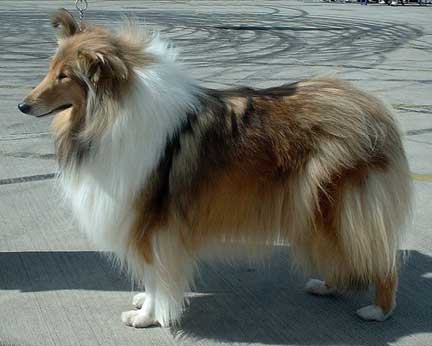
A Rough Collie. (Photo from Wikipedia by sannse
at the City of Birmingham Championship Dog Show, 30th August 2003
and licensed under the Creative Commons Attribution-Share Alike 3.0 Unported.)
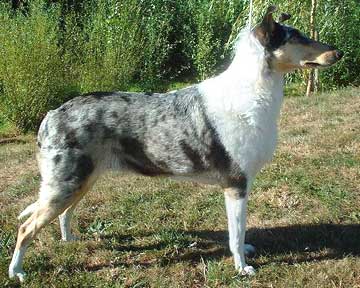 Left, a Smooth Collie. (Photo downloaded from en.wiki, licensed under the Creative Commons Attribution-Share Alike 3.0 Unported.)
Left, a Smooth Collie. (Photo downloaded from en.wiki, licensed under the Creative Commons Attribution-Share Alike 3.0 Unported.)
Both the Rough Collie and the Smooth Collie developed from the same working collie stock that the Border Collie developed from, but they were soon taken over by the dog fancy. Linda Rorem has said, "When dog shows began to be held, the Rough Collie and Smooth Collie were among the earliest sheepdogs developed as 'breeds'." The earliest dog shows took place between gentlemen with sporting/hunting dogs, followed by ladies with toy breeds. However, the middle and lower classes were not immune to competition that brought prestige, and whereas livestock was not within their means or environment, dogs were affordable and accessible. The elite chose to restrict that access by developing elaborate systems for classifying and certifying dogs.
Queen Victoria is often blamed for having "spoiled" the collie breed by her patronage. But is this assertion true?
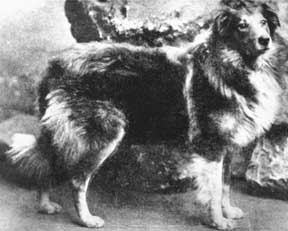
Right, Champion Ormskirk Charlie (b. 1889), who belonged to R.S. Piggen, was an early show collie of whom Combe et al said "[He] is noteworthy as a dual-purpose dog, distinguishing himself both at sheepdog trials and occasionally in the show ring." (Copyright Rough Collies of Distinction and its compilers, reprinted with kind permission.)
William Secord writes: "Perhaps because the Collie was once considered a plain working dog, few authors have written in any depth about it. Of Scottish ancestry, it was originally introduced to England by shepherds bringing their flocks over the borders. Once taken up by the Victorian show fancy, it a became fashionable breed and by 1895 there were seven separate breed clubs, many of which sponsored all-Collie shows. As a result the conformation of the Collie changed substantially in a matter of fifty years. What once had been a rough and ready working dog was, by 1896, an elegant, refined show dog."
Words like "elegant" and "refined" were often applied, and continue to be applied, to distinguish the show collie from the working collie, but beauty is in the eyes of the beholder. Whether Queen Victoria ever used these words or even consciously strove for a change in type is not really known. That she admired the working collie is abundantly clear. According to Hilda Kean, "Queen Victoria...took as pets collie dogs, which had previously been considered shepherd's dogs, quite unpretentious animals."
This seems to imply that once in the hands of show breeders, the "unpretentious" collie became artificial or ornate. However, Victoria, who had a genuine fondness for all animals, would have seen dogs working while at her estate at Balmoral in Scotland, and indeed, in her diary she mentions working dogs. She had a sheep farm at Balmoral worked by two of John Brown's brothers. While Victoria's collies were pets and not working dogs, they were not by any stretch of the imagination the show collies of today, to which the photographs attest. Victoria herself only briefly showed her collies.
However, as Harriet Ritvo points out, "When very high rank was at issue, some fanciers were willing to sacrifice even the meritocratic competition that structured their activities. The participation of royalty was especially coveted....Elite patronage could boost the stock of a breed, as fanciers strove to identify their own tastes with those of their social superiors. Collies, Queen Victoria's favorite breed, were the most conspicuous beneficiaries of such preference...."
It follows, therefore, that the Queen's patronage alone was enough to catapult the collie into prominence in the show ring; and even though she herself may not have been a major exhibitor, once in the ring the collie was subject to the whim of fashion. Still, her sponsorship may have also drawn attention to the working variety, and may have encouraged those who valued the collie as a working dog to preserve, protect, and promote the collie as a working breed. It is indeed the case that aristocratic patronage of sheepdog trials is valued, even today.
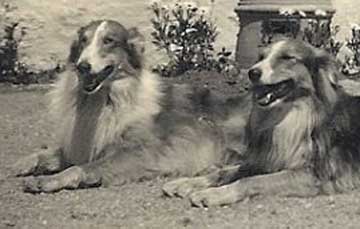
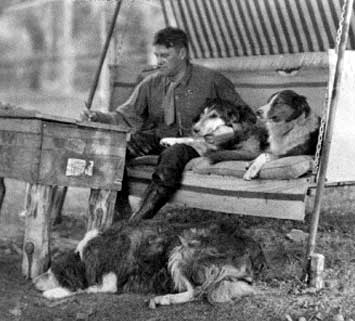 An old photo (early 20th century) of two collies which shows that while some were already the long-nosed, narrow-headed dog they were becoming, others still retained an old-fashioned, broad-skulled, moderate look, even belonging to the same person. Albert Payson Terhune, the author, who promoted the show collie extensively in his writing, owned dogs of both types early in his career. (Photographer unknown.)
An old photo (early 20th century) of two collies which shows that while some were already the long-nosed, narrow-headed dog they were becoming, others still retained an old-fashioned, broad-skulled, moderate look, even belonging to the same person. Albert Payson Terhune, the author, who promoted the show collie extensively in his writing, owned dogs of both types early in his career. (Photographer unknown.)
Right, Albert Payson Terhune, writing at an outdoor desk at Sunnybank early in his career, with three of his dogs. As you can see, they are each a different type. The dog lying on the ground is a large, big-boned dog with a broad, deep muzzle and head. The one on the bench directly next to Terhune has a long muzzle and smallish eyes indicative of the modern Collie. The one on the far right of the bench is much closer to its roots in the old working collies of the 19th century. (Photo source unknown.)
Photographs of early show collies illustrate a dog not much different in looks from its working cousins, but as various people and groups began to breed to extremes according to their own standards of beauty, the show collie began to change physically and dramatically. Iris Combe wrote: "Around this time [1879] Rough Collies were becoming fashionable as companions so breeders tended to select puppies with a more aristocratic appearance rather than for their working abilities... [which] produced a more elegant and refined type of Collie...." For those who think, however, that this was a matter of esthetics alone, one need only to read Rawdon Lee: "[B]efore the establishment of dog shows, a five pound note was fair value for the best working animal that could be produced; now he will bring more than twenty times that sum for his good looks alone."
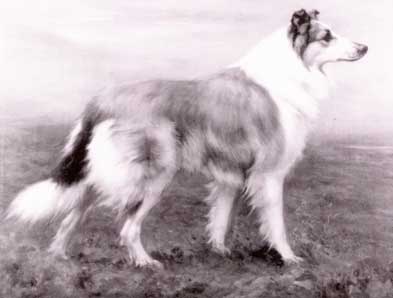 "Collie" by Maud Earl.
"Collie" by Maud Earl.
Lee and others of his contemporary journalists promoted the Rough Collie and devalued the working sheepdog to the extent that show breeders strove to distance themselves and their breed as much as possible from the actual herding dog while at the same time appearing proud of their breed's "humble origins". In 1919, National Geographic magazine said: "There is little resemblance between the working 'collie' of the Scottish sheep-herder and the elaborately furred, slender faced, bench-dog now so popular. The broad-skulled, rather neglected looking 'shepherd dog' of our boyhood, with his friendly, democratic manners (or lack of them) would get short shrift now at any show or gathering of the elite, while of all dogs, his handsome, richly frilled descendant, with all the ear-marks of aristocracy, is the cause of more 'Ohs' and 'Ahs' than any other dog in the show." Much of this we have already covered in previous articles in this series.
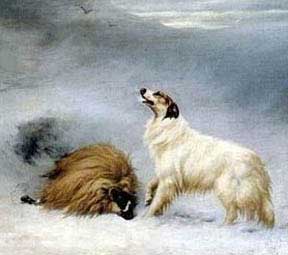
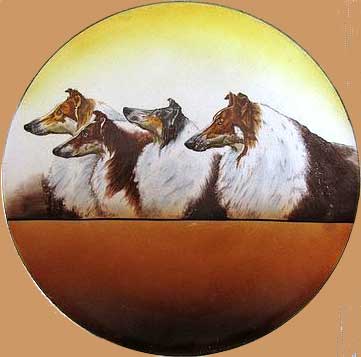 Left, "Found" by Maud Earl.
Left, "Found" by Maud Earl.
Right, "Four by Honors" by Maud Earl.
Victorian artists often exaggerated the looks of the collies they were painting, so that while artists were influenced by the changes taking place in the breed, they also influenced the Fancy. Particular among those was Maud Earl (1864-1943). Even when Earl placed collies in a Highland scene, as in her interpretation of "Found" (compare this to the dog in Albrecht Schenck's "Found"), they don't look much like working collies. Breeders may have considered artist's renditions to be ideal, and strove for that appearance in their lines. In Earl's painting, "Four By Honors" we see an extreme exaggeration of the collies' muzzles. Did the breeders of the day think this beautiful and strive for it?
Today, the Smooth Collie is considered a variety of the same breed as the Rough Collie in the United States. This means that interbreeding is sanctioned by the Collie Club of America, and records are kept for Collies in general rather than for each type individually. In other countries, including the UK since 1993, they are considered separate breeds.
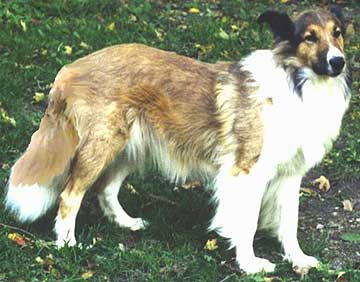 Tracy of Fordwich, a Victorian-type collie that belonged to Gina Bisco of Syracuse, New York, was born and registered in Canada. Notice the relatively wide head, a shorter muzzle, a real stop, and relatively large eyes.
Tracy of Fordwich, a Victorian-type collie that belonged to Gina Bisco of Syracuse, New York, was born and registered in Canada. Notice the relatively wide head, a shorter muzzle, a real stop, and relatively large eyes.
There are a number of organizations, particularly in the United States, that emphasize the Collie's origins in the old working collies of Britain (see below). That said, it is probably true that there are no Rough or Smooth Collies today working seriously on the hills and farms of their native land. If anyone knows of any, I would certainly like to hear about them. Meanwhile, a few Collie owners, particularly in the United States, participate in dog sports and herding with their dogs and consider them "working Collies".
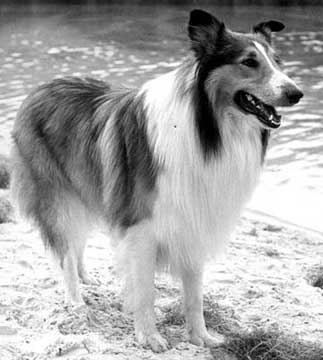 Left, Lassie filming a movie on location in Florida in 1965. (Photo released to the public domain by the Florida Memory Project, State Archive of Florida.)
Left, Lassie filming a movie on location in Florida in 1965. (Photo released to the public domain by the Florida Memory Project, State Archive of Florida.)
Collies, especially Rough Collies, have been very popular from the time the breed was first developed. They have appeared in a large number of novels, particularly the oft reprinted Lassie Come-Home by Eric Knight, and the books of Albert Payson Terhune. Collies have also appeard in numerous films, notably the ones featuring Lassie, initially based on the Knight tale. A line of Rough Collies, originally owned by Rudd Weatherwax, have stared in the Lassie movies, and Lassie has her own star on the Hollywood Walk of Fame.
Resources:
The American Working Collie Association
Friends of the Old Farm Collie
Combe, Iris, Dareen Bridge, and Pat Hutchinson. Rough Collies of Distinction, A Pictorial Record of Influential British Rough Collies From the 1860s to the Present Day, 2001.
Kean, Hilda. Animal Rights: Political and Social Change in Britain Since 1800, Reaktion Books, 1998.
Lee, Rawdon. A History and Description of the Collie or Sheep Dog, Horace Cox, 1890.
Fuertes, Louis Agassiz, and Ernest Harold Bynes. "Our Common Dogs", National Geographic Magazine, Volume 35, Issue 2, January 1919.
Landauer, Christopher. The Victorian Collie Myth
Presberg, Carole L.
"The History of the Shepherd's Dog: Queen Victoria and the Shepherd's Dog in the Victorian Era", International Sheepdog News, July/August 2011.
"The History of the Shepherd's Dog: The Portrayal of the Shepherd's Dog in Art in the Victorian Era", International Sheepdog News, September/October 2011.
"The History of the Shepherd's Dog: Border Collie Cousins: The Collie Breeds of Britain and Ireland", International Sheepdog News, March/April 2012.
Ritvo Harriet. The Animal Estate: The English and Other Creatures in the Victorian Age, Harvard University Press, 1987.
Rorem, Linda. Herding on the Web
Secord, William. Dog Painting 1840-1940: A Social History of the Dog in Art, Antique Collectors Club, 1992.
Copyright © 2013 by Carole L. Presberg
Return to
![]()
BORDER COLLIE COUSINS
THE OTHER WEB PAGES WE MAINTAIN
These web pages are copyright ©2013
and maintained by webmeistress Carole Presberg
with technical help from webwizard David Presberg
ALL RIGHTS RESERVED
If you are interested in using ANY material on this website, you MUST first ask for permission.